Qinetiq has been awarded a £6.7 million contract for Phase 1 of ‘Project Vampire’, a project aiming to procure low-cost fixed-wing drones for intelligence, surveillance and reconnaissance activities in addition to threat simulation.
According to the contract award notice, the outline of the project is as follows.
“Project VAMPIRE sits within the Develop Directorate of Navy Command and aims to address a number of capability problem sets utilising a low-cost Fixed Wing Uncrewed Air Vehicle (UAV) as a means for the development of operational concepts, payload types, and associated communication and digital architecture.”
According to the contract notice, Phase 1 of project Vampire will run as a 4 year project with an option to extend by 1 year until 31 March 2026.
The project is being contracted to deliver the following:
- Four Air Vehicles (In Royal Navy livery as agreed with the authority), with one additional per year in 2023-24 and 2024-25, with options to purchase up to 10 more and an option to extend the contract until 31/03/2026.
- One Launcher with options to purchase up to 2 more.
- One ground control station and aerials, with options to purchase up to 2 more.
- Training for operators in 2022-23, with a repeat in 2024-25.
- Maintainer training for first-line servicing in 2022-23, with a repeat in 2024-25.
Key Specifications
- Max operating altitude more than 35,000ft AMSL
- Sea Skimming operations Min operating altitude below 50ft ASL
- Min operating altitude below 20ft ASL
- Operating speeds Speed more than 250m/s
- Manoeuvrability up to 9G
- Low observability Desirable for IR, and NATO frequency bands C – K
- Payloads including tracked, guided, or fused weapon systems
- Flares, IR, and Chaff dispenser
- Payload bay capabilities between 25Kg and 100kg
- Endurance with a full payload of 1 hour.
- Suitability for maritime environments (salt ingress, deck mobility)
- Air Vehicle to be equipped with IFF (modes 3/A and C) and ADS-B.
- Remotely piloted option.
- The air vehicles shall have an agreed paint colour scheme (DAP 119A-0601-08) and display Royal Navy and UK national markings and serial numbering.
This follows the demonstration of drones on board HMS Prince of Wales last year. HMS Prince of Wales has launched jet-powered drones from her flight deck as the Royal Navy started to explore the use of crewless technology on the Queen Elizabeth-class aircraft carriers. It is understood that the demonstration with HMS Prince of Wales looked at how the drone and associated support equipment, including launcher, can be integrated within a busy ship and flight deck.
Banshee drones were launched from the ship and recovered to land via parachute.
According to a news release here:
“Fixed-wing drones – called the QinetiQ Banshee Jet 80+ – flew from the carrier’s vast flight deck to assess how they might be used to train personnel in defending against ever-more-capable fast jets and missiles. The jet-powered Banshee, which looks like a mini fighter aircraft, can soar to 25,000ft, skim just above the waves, and flies at speeds up to 400 knots (around 460mph). It is hard to detect on radar, giving it all the likeness of an incoming missile – making it a realistic adversary for sailors to train in countering aerial threats.
These drones could eventually be carried by Royal Navy warships and provide operational training to task groups wherever they might be in the world, allowing them to conduct air defence exercises on demand to test reactions and hone responses. And the Banshee’s carrying capacity means the Royal Navy can use it for testing future sensors, weaponry and radio equipment.”
Drones on the carriers?
Alongside the above, carrier-based drones under ‘Project Vixen’ are also being considered for a range of missions including combat, aerial refuelling and airborne early warning but what could they look like?
According to an official Royal Navy publication, titled Future Maritime Aviation Force, which was originally published in December 2020, the Royal Navy aims to replace its helicopter-based airborne early warning (AEW) platform, the Merlin HM2 Crowsnest, with a fixed-wing UAV, currently known as Vixen, by 2030.
The Royal Navy also expects to utilise Vixen in surveillance, air-to-air refuelling, electronic warfare and strike roles. A slide from the publication shows that Vixen could be used for airborne early warning, strike, aerial refuelling and more.
You can read more about the aerial surveillance side of things by clicking here and the aerial refuelling aspect by clicking here.


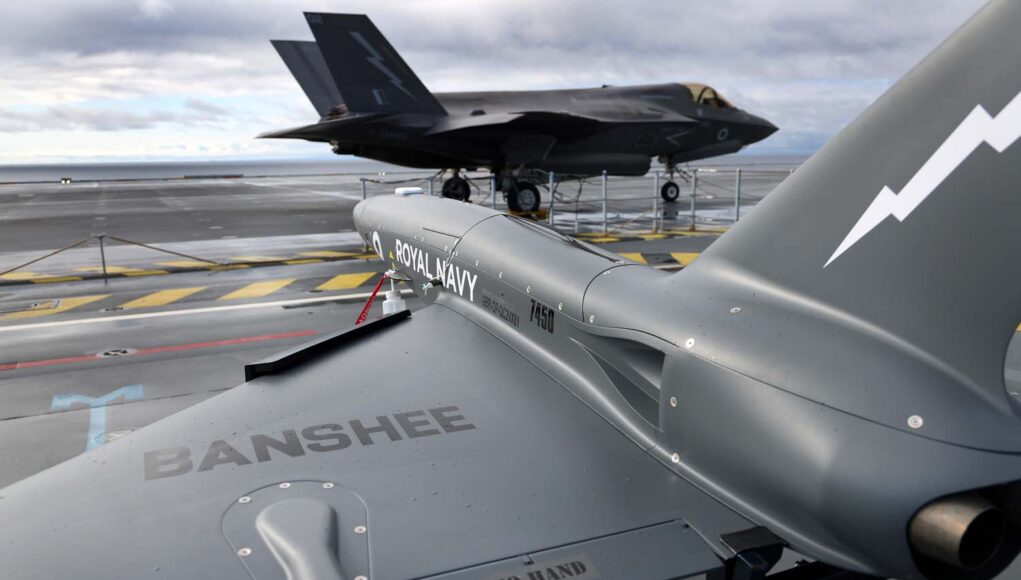
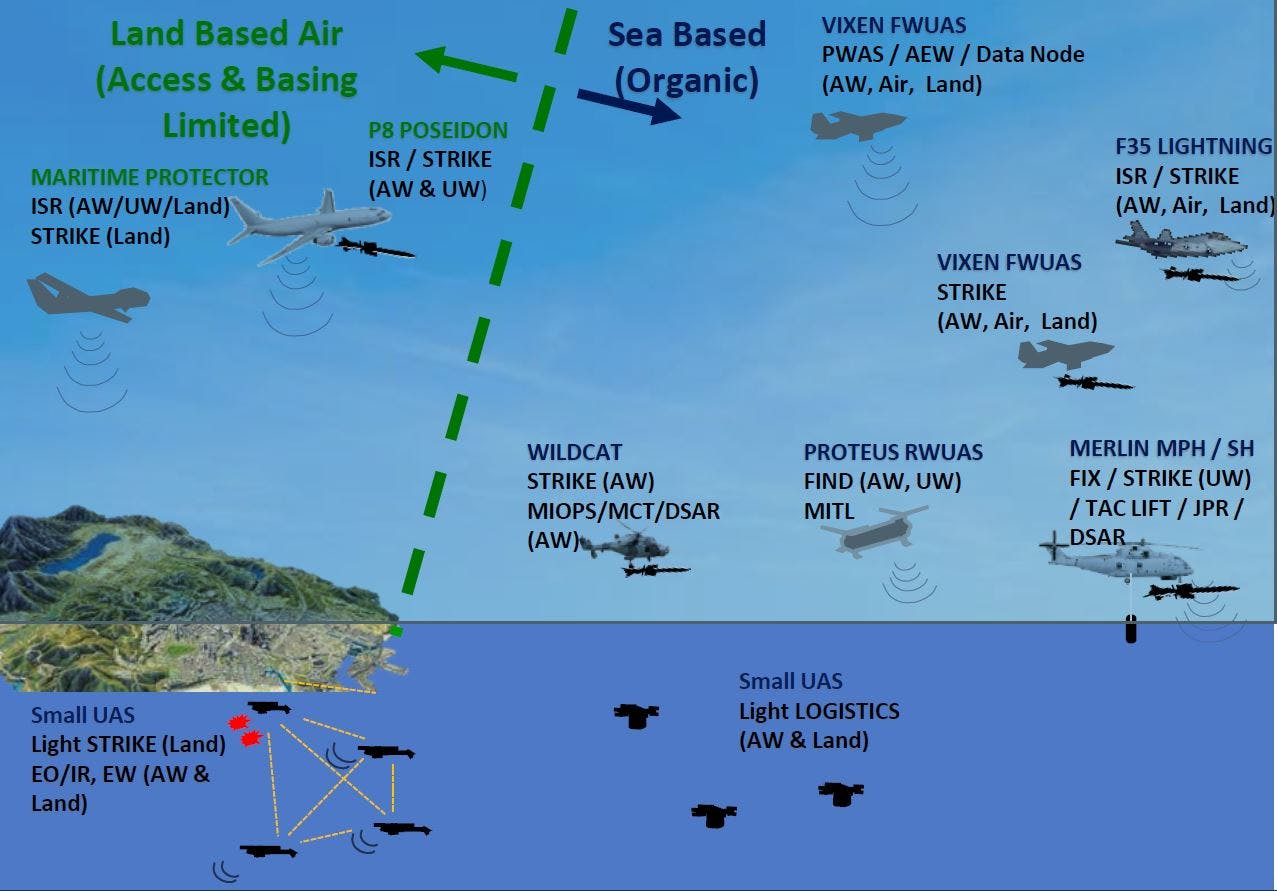
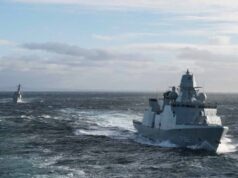
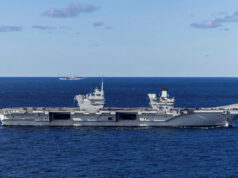
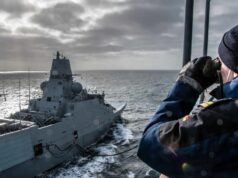
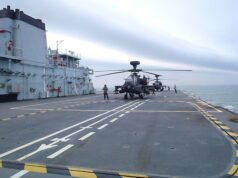

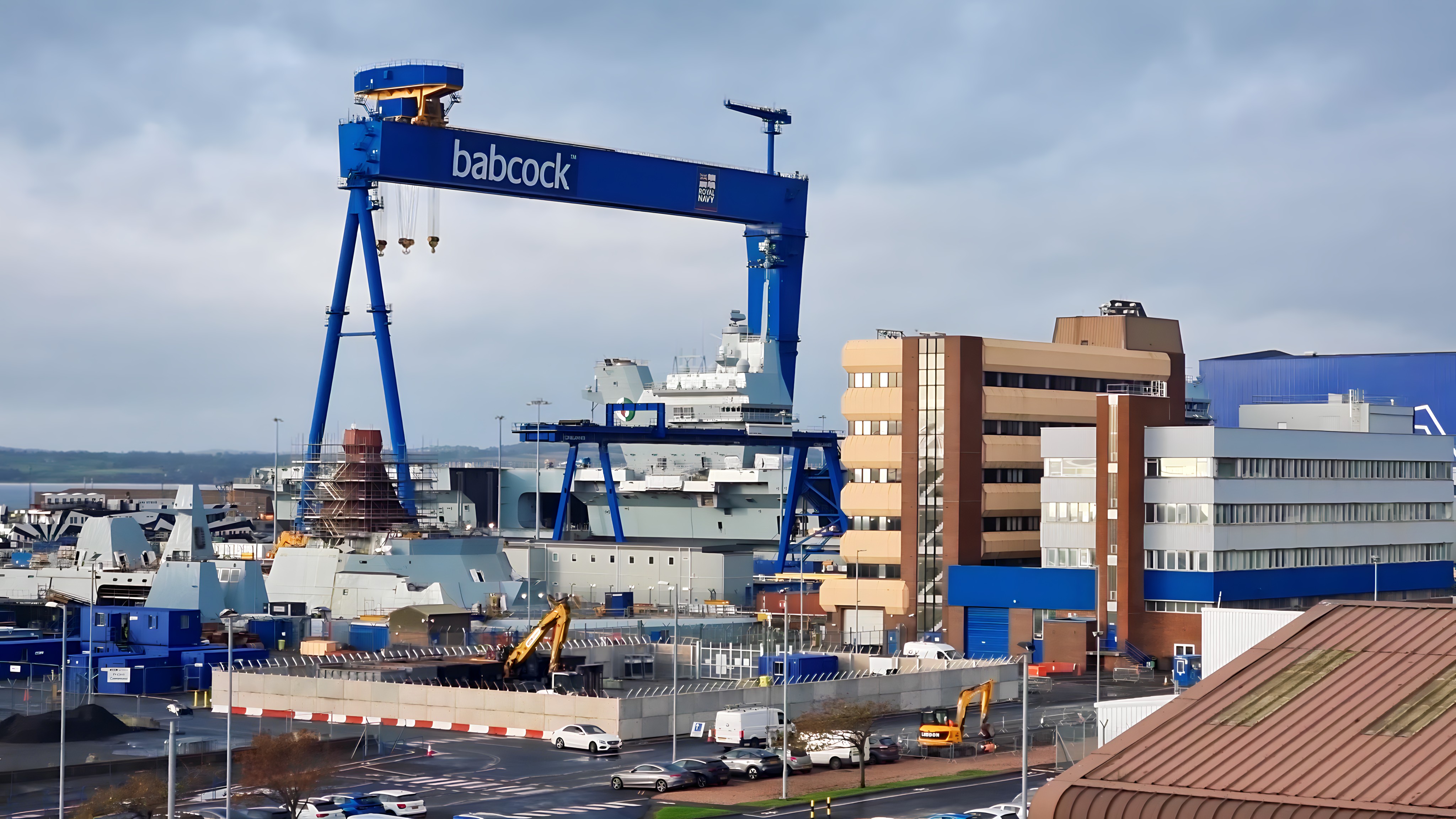
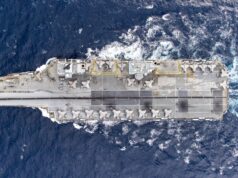

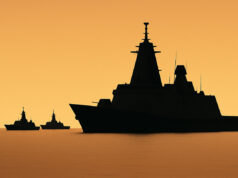
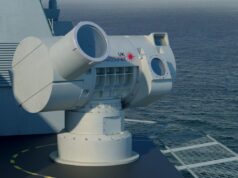

Would it ever make sense to put some switchblade 300/600s on navy vessels or even choppers? I am not sure if they are inert if they don’t impact and there is always salt ingress that is a concern if they are recoverable.
We should definitely have some camcopter 100s as standard across the fleet especially on rivers. Massive force multiplier for those vessels. Comes even as iso container
They would have marginal performance at sea due to their slow speed and short range. Switchblade is more of a replacement for traditional mortar and close artillery support.
For targeting Somali pirates? But even then a machine gun does that just fine.
Even in swarms, something as slow as Switchblades would be like a duck shoot in the terrainless high seas.
So 4 UAVs with an endurance of 1 hour and which have to be recovered from the water each time. It would be interesting to know the turn over time from splash down to take off, something tells me it is a lot longer than 1 hour. Meaning during a time of high intensity, the carrier would be unable to use its UAV fleet after 5 hours and which to me is the reason why each RN ship should be equipped with some form of VTOL UAV which allows for a quick turn around. To me this has the makings of the Phoenix UAV saga , I mean landing them in the sea by parachute in this day and age.
CAMCOPTER® S-100 System – Schiebel and probably 10 other similar options for that (what happened to the Leonardo option). S-100: Multitude of sensors, with two per container always have one on station.
I think these more for training/threat simulation than real surveillance work
They are.
They are TOO slow to simulate a contemporary Russian/Chinese ASM. I think they are a Turkey. If you want to simulate a modern ASM buy a supersonic drone.
They should certainly tender for the development of a multi-layered low-air resistance flexible composite retrieval device to be able to recover them without them ditching in the sea – some might call it a big net!
They are catching re entering rockets out of the air these days, one might have thought something similar for this might be considered, lot easier to predict it’s location and timing one might have thought.
Isn’t the article talking about the drones previously used being recovered from the water? Or am i mis-reading something?
Considering it’s a drone with an endurance of 1 hour, I don’t think the mission type is really sustained use. It would be convenient if it landed but it won’t necessarily be able to go straight back into service.
A STOVL aircraft would be much larger and more expensive – probably more endurance but by then it’s a different platform altogether.
Maybe they should integrate some sort of system that can time the parachute landing on the ship? Or have a better system of recovery.
Why not just recover it with a net on the ship…
I am mot convinced by this drone… what is it, it is fast but not that fast, has poor endurance and cannot carry that much…
As a ASM trainer it is too slow. Russian/Chinese ASM are now mostly super/hyper-sonic…
This is a drone looking for a role…
Its about time, Turkey has at Kızılelma drone already in production which they will use on their amphibious assault ship.
It is always a balance between Good Enough = TB2 and keeping the big technological edge = SAMPSON
Yes, we could probably knock out some pretty decent drones quickly but would they add much to the party?
The reality is that we can probably switch off the TB2s like we have switched off the Russian drones. And if you go down the pathway of cheap stuff an inventive enemy will do the same.
You cannot rely on every enemy being as useless as the Russians are proving to be. TBH the Argentineans were a lot more inventive, with for instance ELINT and reprogramming EXOCET in ’82 than the Russians are being in Ukraine.
The fact the Russians have not managed to make the TB2’s useless says a lot for how useless their EW capabilities are.
But I do agree the camcopter drones on the Rivers for police type work makes sense as drug runners don’t have EW!
What is perhaps more surprising is that Russia knew all about the TB2s as they’ve been used by Ukraine in the Donbass and Luhansk regions for a couple of years now. Then there was the Armenian and Azerbaijan war just recently, that also featured the TB2. It has been used over Syria and also in Libya, where Russian have also been operating. So in theory they should have had time to develop a counter to it. But recent experience says different.
Yep, definitely S100s for the Rivers.
While it is easy to make a paper comparison between Kizilelma and Vampire/Vixen and see that the Turkish uas has many advantages, not least being cost, it’s worth remembering that their effectiveness will largely depend on the programming that runs them. Time will tell.
Yet, even a cheap drone that can carry a couple of ASM/Meteor stationed 200+ miles from your carrier, provides a very valuable picket defence. A drone has legs that the F35B simply hasn’t got, plus it can be very stealthy causing any enemy to trip over it.
It doesn’t even have to be that fast, does it?
Does the army have anything similar to this, or anything similar to the Turkish TB2?
The equivalent of the TB2 is the MQ-9A Reaper which has been in British service since 2004-2006.
It will begin being superseded by the MQ-9B Protector starting from 2023. The MQ-9B is mostly the same but is certified to fly in civilian airspace and is more robust than the A better able to survive adverse weather/bird strikes.
Trouble is that there are too many good idea bods about and no one with real intell about what is good or bad + do they have a real budget for such???
The S100 would be a winner for the Rivers and even could be added to the larger units. Great off the shelf quality and it would be a big + for the units so equipped. It’s sensible but then every-time something sensible comes along the powers just sail by it.
FAA needs some real investment to double up on the fleet to ensure there are enough cabs to go round when really needed. Two large flat tops with little to go on them, what a waste.
There’s a bad people out there and you can only stop them when you too are STRONG in numbers as well as QUALITY
I know we’ve all assumed these will be Banshee, but those are only at the lower band of the performance envelope being requested (especially in terms of payload. That’s the Banshee NG, for reference. That doesn’t carry weapon systems, not ISR packages as far as I can tell- not sure if it has the kind of datalink to allow realtime data transfer, not the remote piloting also listed by the RN as a requirement.
Might there be something else in the wings?
From Qinetiq themselves. The Banshee NG is at the first stage of development. They want to increase its speed to high transonic, therefore speeds in excess of Mach 0.75. It can currently carry a 25kg payload. Which is used for the target decoys, such as the IR hot nose, radar repeaters, chaff and flares etc. But it can also carry the Rattler supersonic target drone. It does use real time telemetry, so can be controlled in near real time in flight or given command updates. Its primary role is a target drone after all. Will the RN be looking to use it in other roles? I actually think they will. It could be used as a decoy drone when approaching unfriendly radars. It could also help pilots flying as a pair to control and develop processes, thereby taking baby steps in progressing to loyal wingman aircraft.
I don’t think this is anything more than a replacement for the disbanding threat simulation Hawks of FRADU, with an option to do a bit of recce’ work.
They need to talk to insitu about buying rights to their skyhook recovery system
Great job. Small budget item that will hopefully deliver something useful. It’s a good stepping stone to bigger and better drones. Having a range of sizes should work out quite well. Could literally have 100’s of drones on a carrier
Honestly this drone looks like having the technology for about 1960… It looks like a target and not a very relevant one for the thread at the moment. Very slow speed short-ranged and recovered by a parachute somewhere over land do not understand this at all.
It is a stepping stone slated to last 4 years, perhaps 5, until the RN decide on what the next generation of drones should be and what needs to be done to the carriers and other ships to operate them. Better to get something now, learn the lessons, allow tech to mature, then go for something on a bigger scale.
Confucius say “read article instead of just looking at photos and commenting”.
The contract is to develop new drones. The picture of the exercise performed on PoW was to see how the RN would operate a drone from a carrier. So they used an off the shelf target drone to test the theory before splurging cash on developing something 🤷🏻♂️🤦🏻♂️
Not sure why you think it is very low speed. Not many current UAV’s around with higher speed than 250 m/s which is 900 km/h.
Although I agree with your points about it’s range and recovery.
This is all well and good, but the carriers are light on aircraft to carry out the surveillance, air-to-air refuelling, electronic warfare and strike roles. There was word of the Mosquito demonstrators doing this role using project Vixen. That was first muted to have been 2030. Yet, the US has now got strike drones and helicopters already flying. Is it the case that the Royal Navy is re-inventing the wheel, albeit really slowly?
From what you can see on the Internet, we are miles behind Turkey, the US, Israel, China, France, even Egypt F.G.S! How far we have slipped. As it stands we have under-protected carriers, not enough to half load out one of them and a drone program that’s far behind other nations.
Until the Royal Navy pulls it’s finger out and gets a reasonably sized and powered system that can perform the surveillance, air-to-air refuelling, electronic warfare and strike roles. I would worry about sending them into harms way.